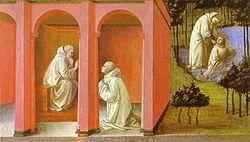- For the martyr of this name, see Saint Placidus (martyr).
Saint Placidus | |
|---|---|
 | |
| Died | 6th century |
| Venerated in | Catholic Church, Eastern Orthodox Church |
| Feast | 5 October |
| Attributes | being rescued from drowning |
| Patronage | Messina (co-patron), Biancavilla, Castel di Lucio, Montecarotto, Poggio Imperiale |
Saint Placidus (also known as Saint Placid) was a disciple of Saint Benedict. He was the son of the patrician Tertullus, was brought as a child to St. Benedict at Sublaqueum (Subiaco) and dedicated to God as provided for in chapter 69 of the Rule of St. Benedict (oblate).
Life
Placidus was the eldest son of the patrician Tertullus. When he was about eight years old, his father placed him under the care of St. Benedict at Subiaco, to be educated. Saint Gregory the Great (Dialogues, II, vii) relates an account of Placidus being rescued from drowning by his fellow monk, Saint Maurus, when, at Saint Benedict's order ran across the surface of the lake below the monastery and drew Placidus safely to shore. It appears certain that he accompanied Saint Benedict when, about 529, he removed to Monte Cassino, which was said to have been made over to him by the father of Placidus.[1]
Of his later life nothing is known, but in an ancient psalterium at Vallombrosa his name is found in the Litany of the Saints placed among the confessors immediately after those of Saint Benedict and Saint Maurus; the same occurs in Codex CLV at Subiaco, attributed to the ninth century.[1]
Veneration
He is venerated together with Saint Maurus on 5 October.[2]
Patronage
He is the co-patron of Messina along with the Madonna of the Letter, and is the official patron of Biancavilla, Castel di Lucio, Montecarotto, and Poggio Imperiale.[3] Because a large portion of Easton, Pennsylvania's Italian community originally came from Castel di Lucio, Saint Placidus is given particular veneration with an annual parade through South Side on the Sunday before Labor Day. The Sunday after is the Feast of the Holy Cross, celebrated by immigrants from the neighboring town of Santo Stefano di Camastra.
References
- ^ a b Huddleston, Gilbert. "St. Placidus." The Catholic Encyclopedia Vol. 12. New York: Robert Appleton Company, 1911. 4 November 2017
- ^ Martyrologium Romanum (Libreria Editrice Vaticana 2001 ISBN 88-209-7210-7)
- ^ it:San Placido
Sources
- Gardner, Edmund G. (editor) (1911). The Dialogues of Saint Gregory the Great (2010 ed.). Merchantville, NJ: Evolution Publishing. ISBN 978-1-889758-94-7.
External links
- St. Benedict's Abbey - Benedictine Brothers and Fathers in America's Heartland
- The Holy Rule of St. Benedict - Online translation by the Rev. Boniface Verheyen, O.S.B., of St. Benedict's Abbey
- Benedictine College - Dynamically Catholic, Benedictine, Liberal Arts, and Residential
![]() This article incorporates text from a publication now in the public domain: Herbermann, Charles, ed. (1913). "St. Placidus". Catholic Encyclopedia. New York: Robert Appleton Company.
This article incorporates text from a publication now in the public domain: Herbermann, Charles, ed. (1913). "St. Placidus". Catholic Encyclopedia. New York: Robert Appleton Company.